Analyzing HRM Practices - BTEC Level 3 Diploma in Business Context
VerifiedAdded on 2023/03/29
|11
|2958
|149
Report
AI Summary
This report provides an overview of Human Resource Management (HRM) within a business context, focusing on key aspects such as internal and external factors influencing human resource planning, the skills employees need to perform their jobs effectively, and strategies for employee motivation. It further explains how organizations can foster employee cooperation and measure employee performance. The report references Maslow's hierarchy of needs as a motivational theory and touches upon practical methods like communication, incentives, and opportunities for advancement to boost employee morale. Additionally, it discusses enforcing company policies, cross-training, and team-building activities to improve employee cooperation. Performance measurement techniques, including punctuality checks, quality assessments, and client surveys, are also highlighted. The analysis is contextualized within the framework of a BTEC Level 3 Diploma in Business, making it a valuable resource for students in this field.
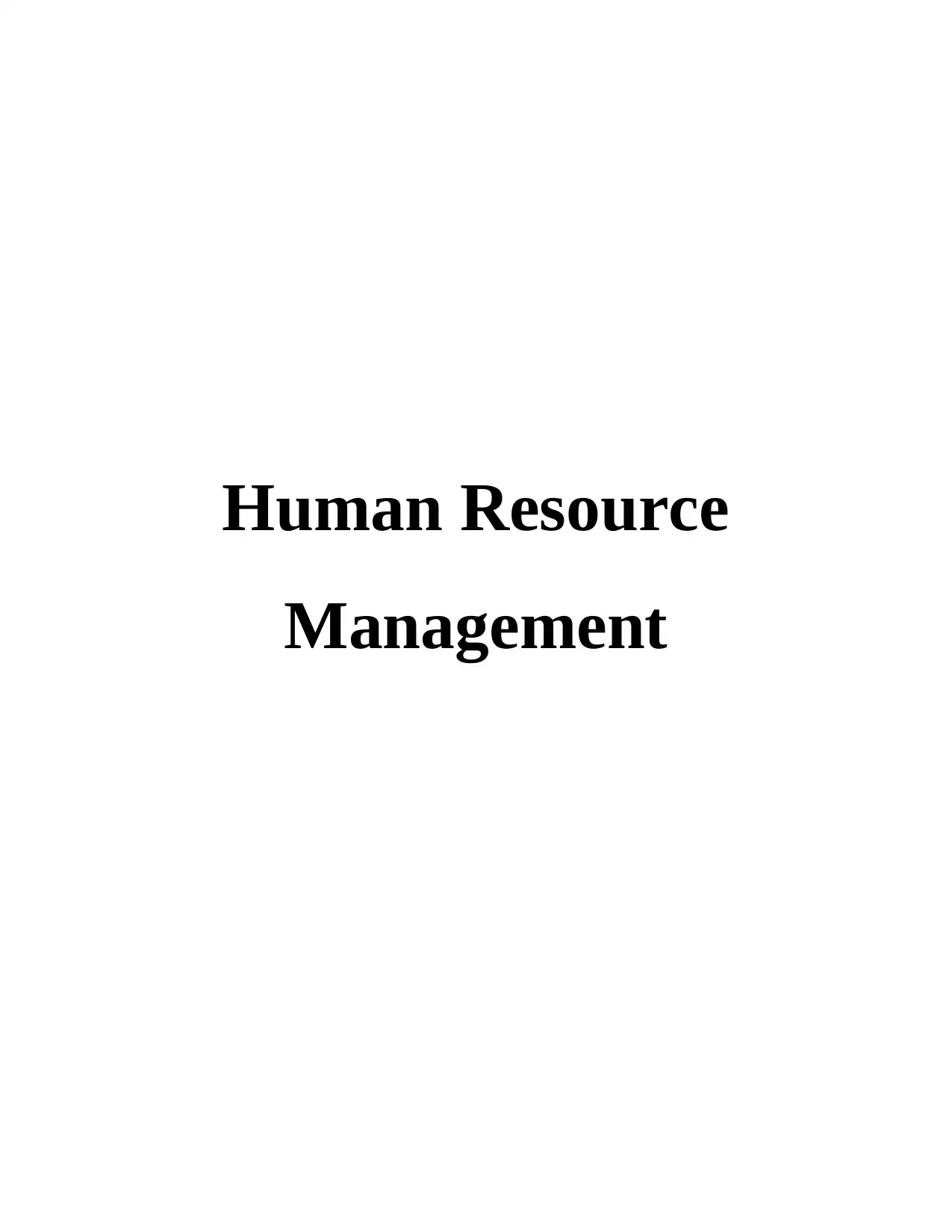
Human Resource
Management
Management
Paraphrase This Document
Need a fresh take? Get an instant paraphrase of this document with our AI Paraphraser
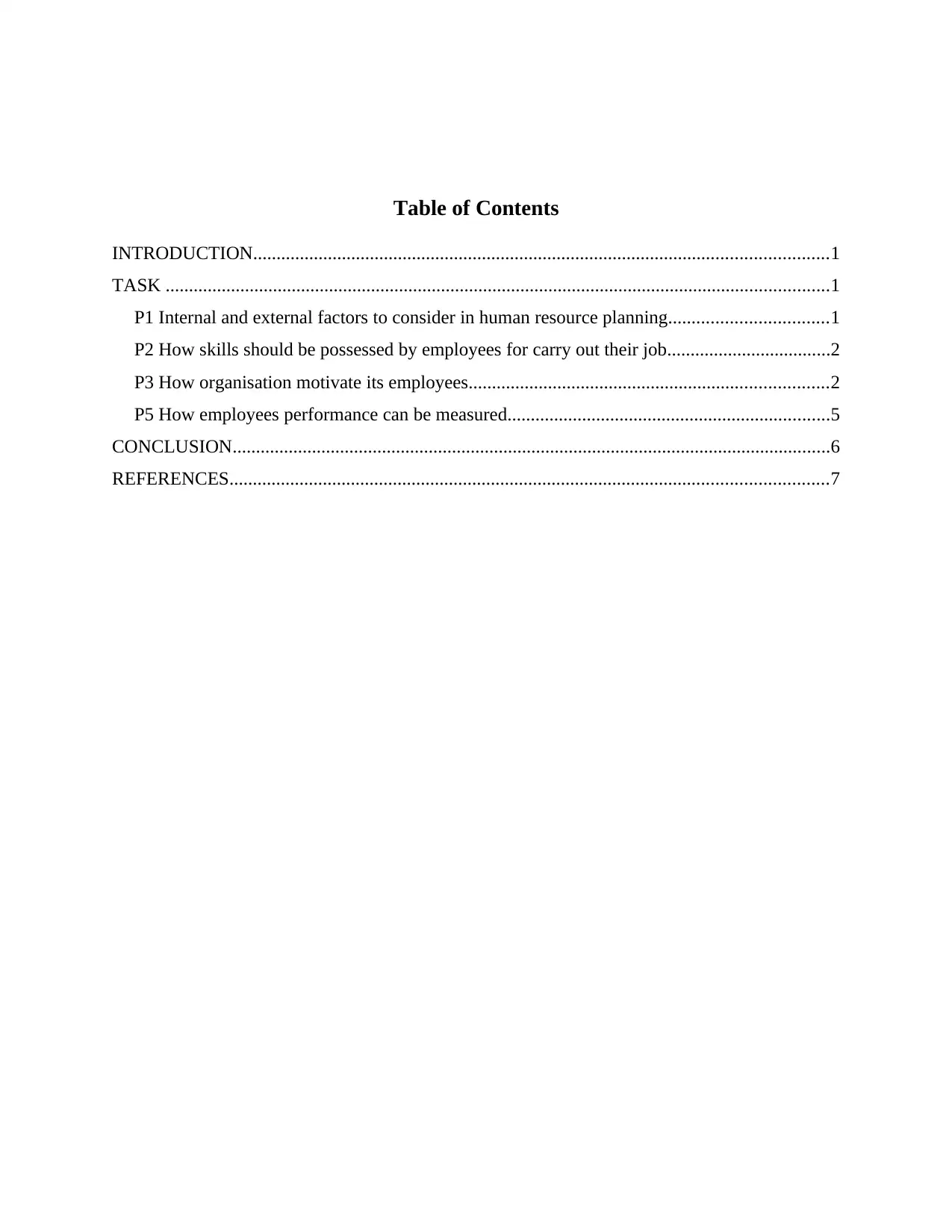
Table of Contents
INTRODUCTION...........................................................................................................................1
TASK ..............................................................................................................................................1
P1 Internal and external factors to consider in human resource planning..................................1
P2 How skills should be possessed by employees for carry out their job...................................2
P3 How organisation motivate its employees.............................................................................2
P5 How employees performance can be measured.....................................................................5
CONCLUSION................................................................................................................................6
REFERENCES................................................................................................................................7
INTRODUCTION...........................................................................................................................1
TASK ..............................................................................................................................................1
P1 Internal and external factors to consider in human resource planning..................................1
P2 How skills should be possessed by employees for carry out their job...................................2
P3 How organisation motivate its employees.............................................................................2
P5 How employees performance can be measured.....................................................................5
CONCLUSION................................................................................................................................6
REFERENCES................................................................................................................................7

⊘ This is a preview!⊘
Do you want full access?
Subscribe today to unlock all pages.

Trusted by 1+ million students worldwide
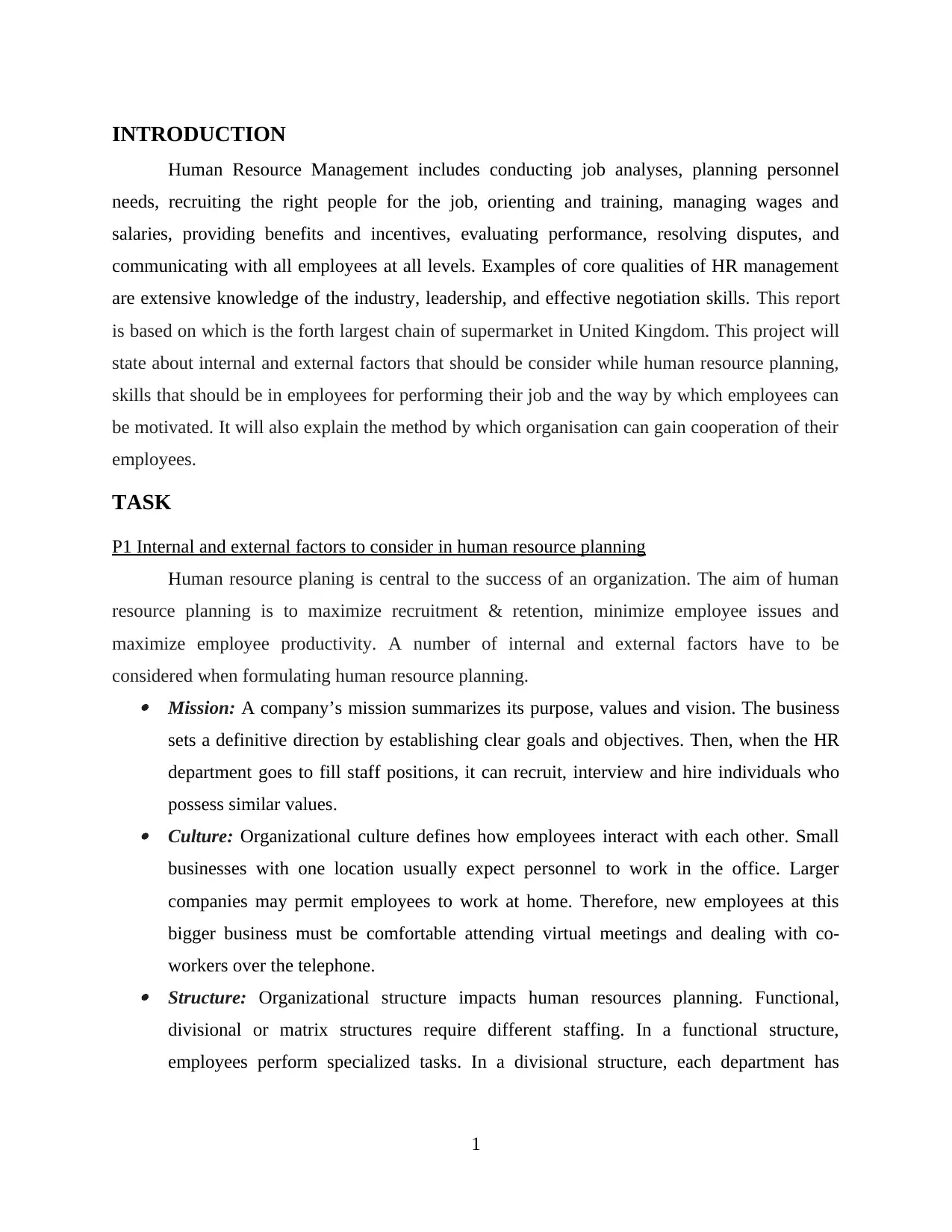
INTRODUCTION
Human Resource Management includes conducting job analyses, planning personnel
needs, recruiting the right people for the job, orienting and training, managing wages and
salaries, providing benefits and incentives, evaluating performance, resolving disputes, and
communicating with all employees at all levels. Examples of core qualities of HR management
are extensive knowledge of the industry, leadership, and effective negotiation skills. This report
is based on which is the forth largest chain of supermarket in United Kingdom. This project will
state about internal and external factors that should be consider while human resource planning,
skills that should be in employees for performing their job and the way by which employees can
be motivated. It will also explain the method by which organisation can gain cooperation of their
employees.
TASK
P1 Internal and external factors to consider in human resource planning
Human resource planing is central to the success of an organization. The aim of human
resource planning is to maximize recruitment & retention, minimize employee issues and
maximize employee productivity. A number of internal and external factors have to be
considered when formulating human resource planning. Mission: A company’s mission summarizes its purpose, values and vision. The business
sets a definitive direction by establishing clear goals and objectives. Then, when the HR
department goes to fill staff positions, it can recruit, interview and hire individuals who
possess similar values. Culture: Organizational culture defines how employees interact with each other. Small
businesses with one location usually expect personnel to work in the office. Larger
companies may permit employees to work at home. Therefore, new employees at this
bigger business must be comfortable attending virtual meetings and dealing with co-
workers over the telephone. Structure: Organizational structure impacts human resources planning. Functional,
divisional or matrix structures require different staffing. In a functional structure,
employees perform specialized tasks. In a divisional structure, each department has
1
Human Resource Management includes conducting job analyses, planning personnel
needs, recruiting the right people for the job, orienting and training, managing wages and
salaries, providing benefits and incentives, evaluating performance, resolving disputes, and
communicating with all employees at all levels. Examples of core qualities of HR management
are extensive knowledge of the industry, leadership, and effective negotiation skills. This report
is based on which is the forth largest chain of supermarket in United Kingdom. This project will
state about internal and external factors that should be consider while human resource planning,
skills that should be in employees for performing their job and the way by which employees can
be motivated. It will also explain the method by which organisation can gain cooperation of their
employees.
TASK
P1 Internal and external factors to consider in human resource planning
Human resource planing is central to the success of an organization. The aim of human
resource planning is to maximize recruitment & retention, minimize employee issues and
maximize employee productivity. A number of internal and external factors have to be
considered when formulating human resource planning. Mission: A company’s mission summarizes its purpose, values and vision. The business
sets a definitive direction by establishing clear goals and objectives. Then, when the HR
department goes to fill staff positions, it can recruit, interview and hire individuals who
possess similar values. Culture: Organizational culture defines how employees interact with each other. Small
businesses with one location usually expect personnel to work in the office. Larger
companies may permit employees to work at home. Therefore, new employees at this
bigger business must be comfortable attending virtual meetings and dealing with co-
workers over the telephone. Structure: Organizational structure impacts human resources planning. Functional,
divisional or matrix structures require different staffing. In a functional structure,
employees perform specialized tasks. In a divisional structure, each department has
1
Paraphrase This Document
Need a fresh take? Get an instant paraphrase of this document with our AI Paraphraser
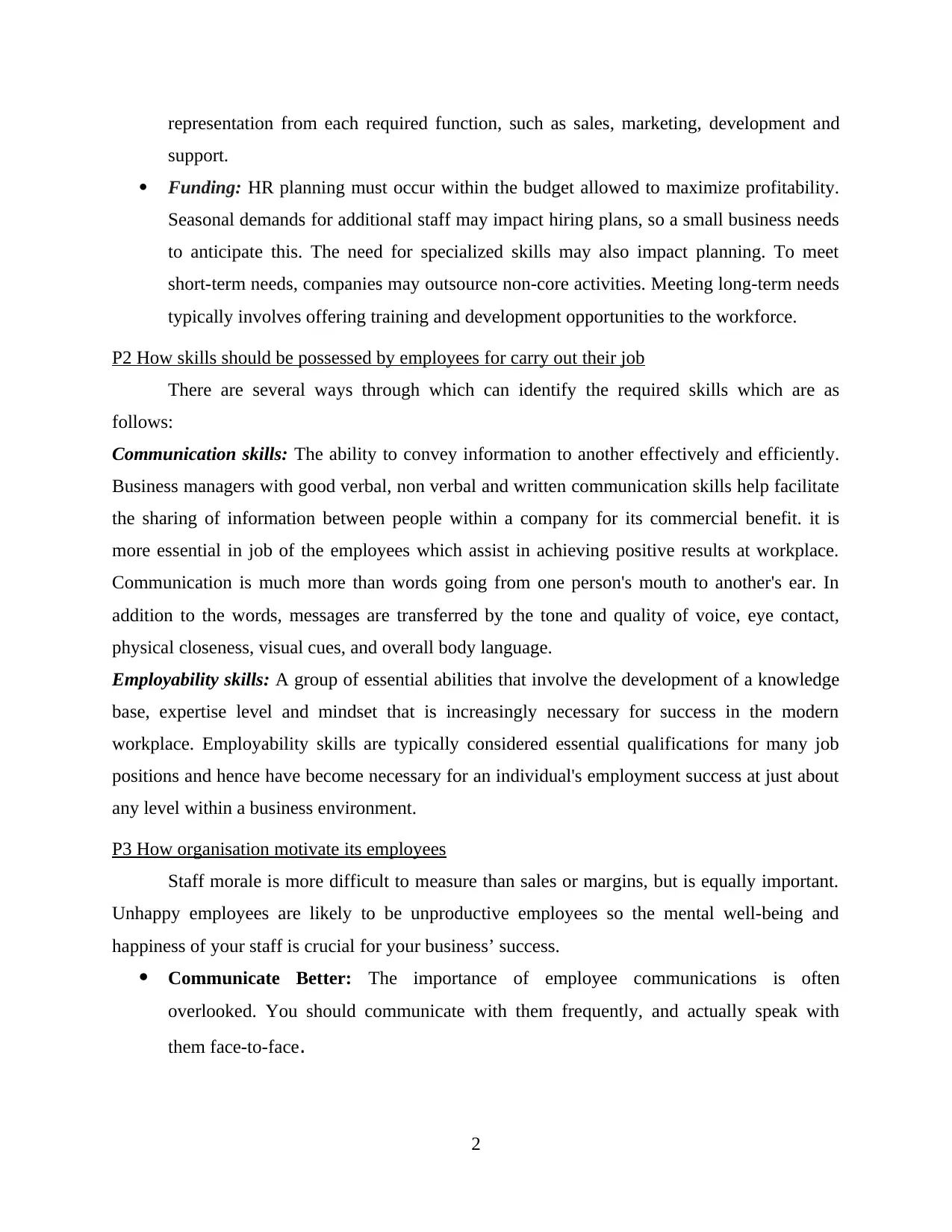
representation from each required function, such as sales, marketing, development and
support.
Funding: HR planning must occur within the budget allowed to maximize profitability.
Seasonal demands for additional staff may impact hiring plans, so a small business needs
to anticipate this. The need for specialized skills may also impact planning. To meet
short-term needs, companies may outsource non-core activities. Meeting long-term needs
typically involves offering training and development opportunities to the workforce.
P2 How skills should be possessed by employees for carry out their job
There are several ways through which can identify the required skills which are as
follows:
Communication skills: The ability to convey information to another effectively and efficiently.
Business managers with good verbal, non verbal and written communication skills help facilitate
the sharing of information between people within a company for its commercial benefit. it is
more essential in job of the employees which assist in achieving positive results at workplace.
Communication is much more than words going from one person's mouth to another's ear. In
addition to the words, messages are transferred by the tone and quality of voice, eye contact,
physical closeness, visual cues, and overall body language.
Employability skills: A group of essential abilities that involve the development of a knowledge
base, expertise level and mindset that is increasingly necessary for success in the modern
workplace. Employability skills are typically considered essential qualifications for many job
positions and hence have become necessary for an individual's employment success at just about
any level within a business environment.
P3 How organisation motivate its employees
Staff morale is more difficult to measure than sales or margins, but is equally important.
Unhappy employees are likely to be unproductive employees so the mental well-being and
happiness of your staff is crucial for your business’ success.
Communicate Better: The importance of employee communications is often
overlooked. You should communicate with them frequently, and actually speak with
them face-to-face.
2
support.
Funding: HR planning must occur within the budget allowed to maximize profitability.
Seasonal demands for additional staff may impact hiring plans, so a small business needs
to anticipate this. The need for specialized skills may also impact planning. To meet
short-term needs, companies may outsource non-core activities. Meeting long-term needs
typically involves offering training and development opportunities to the workforce.
P2 How skills should be possessed by employees for carry out their job
There are several ways through which can identify the required skills which are as
follows:
Communication skills: The ability to convey information to another effectively and efficiently.
Business managers with good verbal, non verbal and written communication skills help facilitate
the sharing of information between people within a company for its commercial benefit. it is
more essential in job of the employees which assist in achieving positive results at workplace.
Communication is much more than words going from one person's mouth to another's ear. In
addition to the words, messages are transferred by the tone and quality of voice, eye contact,
physical closeness, visual cues, and overall body language.
Employability skills: A group of essential abilities that involve the development of a knowledge
base, expertise level and mindset that is increasingly necessary for success in the modern
workplace. Employability skills are typically considered essential qualifications for many job
positions and hence have become necessary for an individual's employment success at just about
any level within a business environment.
P3 How organisation motivate its employees
Staff morale is more difficult to measure than sales or margins, but is equally important.
Unhappy employees are likely to be unproductive employees so the mental well-being and
happiness of your staff is crucial for your business’ success.
Communicate Better: The importance of employee communications is often
overlooked. You should communicate with them frequently, and actually speak with
them face-to-face.
2
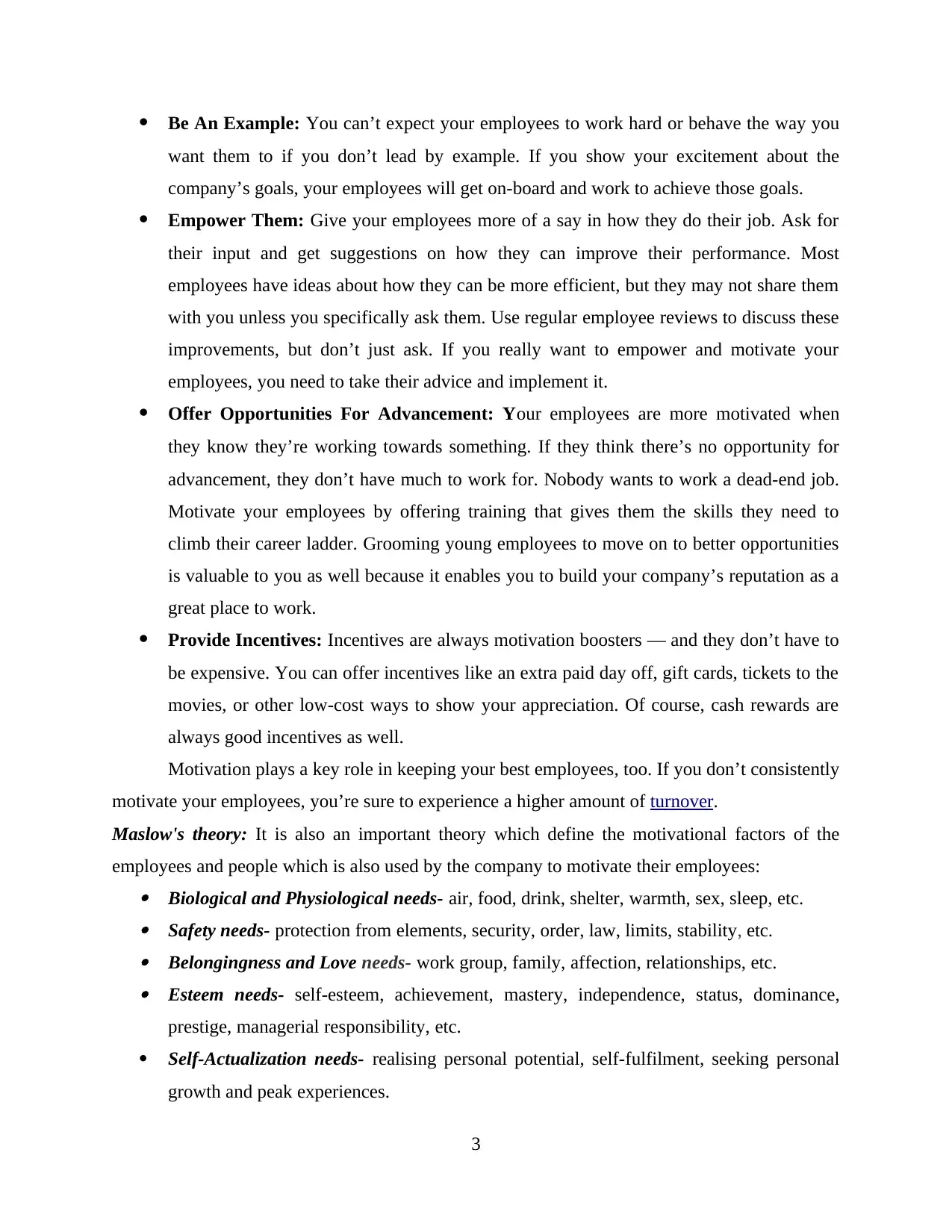
Be An Example: You can’t expect your employees to work hard or behave the way you
want them to if you don’t lead by example. If you show your excitement about the
company’s goals, your employees will get on-board and work to achieve those goals.
Empower Them: Give your employees more of a say in how they do their job. Ask for
their input and get suggestions on how they can improve their performance. Most
employees have ideas about how they can be more efficient, but they may not share them
with you unless you specifically ask them. Use regular employee reviews to discuss these
improvements, but don’t just ask. If you really want to empower and motivate your
employees, you need to take their advice and implement it.
Offer Opportunities For Advancement: Your employees are more motivated when
they know they’re working towards something. If they think there’s no opportunity for
advancement, they don’t have much to work for. Nobody wants to work a dead-end job.
Motivate your employees by offering training that gives them the skills they need to
climb their career ladder. Grooming young employees to move on to better opportunities
is valuable to you as well because it enables you to build your company’s reputation as a
great place to work.
Provide Incentives: Incentives are always motivation boosters — and they don’t have to
be expensive. You can offer incentives like an extra paid day off, gift cards, tickets to the
movies, or other low-cost ways to show your appreciation. Of course, cash rewards are
always good incentives as well.
Motivation plays a key role in keeping your best employees, too. If you don’t consistently
motivate your employees, you’re sure to experience a higher amount of turnover.
Maslow's theory: It is also an important theory which define the motivational factors of the
employees and people which is also used by the company to motivate their employees: Biological and Physiological needs- air, food, drink, shelter, warmth, sex, sleep, etc. Safety needs- protection from elements, security, order, law, limits, stability, etc. Belongingness and Love needs- work group, family, affection, relationships, etc. Esteem needs- self-esteem, achievement, mastery, independence, status, dominance,
prestige, managerial responsibility, etc.
Self-Actualization needs- realising personal potential, self-fulfilment, seeking personal
growth and peak experiences.
3
want them to if you don’t lead by example. If you show your excitement about the
company’s goals, your employees will get on-board and work to achieve those goals.
Empower Them: Give your employees more of a say in how they do their job. Ask for
their input and get suggestions on how they can improve their performance. Most
employees have ideas about how they can be more efficient, but they may not share them
with you unless you specifically ask them. Use regular employee reviews to discuss these
improvements, but don’t just ask. If you really want to empower and motivate your
employees, you need to take their advice and implement it.
Offer Opportunities For Advancement: Your employees are more motivated when
they know they’re working towards something. If they think there’s no opportunity for
advancement, they don’t have much to work for. Nobody wants to work a dead-end job.
Motivate your employees by offering training that gives them the skills they need to
climb their career ladder. Grooming young employees to move on to better opportunities
is valuable to you as well because it enables you to build your company’s reputation as a
great place to work.
Provide Incentives: Incentives are always motivation boosters — and they don’t have to
be expensive. You can offer incentives like an extra paid day off, gift cards, tickets to the
movies, or other low-cost ways to show your appreciation. Of course, cash rewards are
always good incentives as well.
Motivation plays a key role in keeping your best employees, too. If you don’t consistently
motivate your employees, you’re sure to experience a higher amount of turnover.
Maslow's theory: It is also an important theory which define the motivational factors of the
employees and people which is also used by the company to motivate their employees: Biological and Physiological needs- air, food, drink, shelter, warmth, sex, sleep, etc. Safety needs- protection from elements, security, order, law, limits, stability, etc. Belongingness and Love needs- work group, family, affection, relationships, etc. Esteem needs- self-esteem, achievement, mastery, independence, status, dominance,
prestige, managerial responsibility, etc.
Self-Actualization needs- realising personal potential, self-fulfilment, seeking personal
growth and peak experiences.
3
⊘ This is a preview!⊘
Do you want full access?
Subscribe today to unlock all pages.

Trusted by 1+ million students worldwide
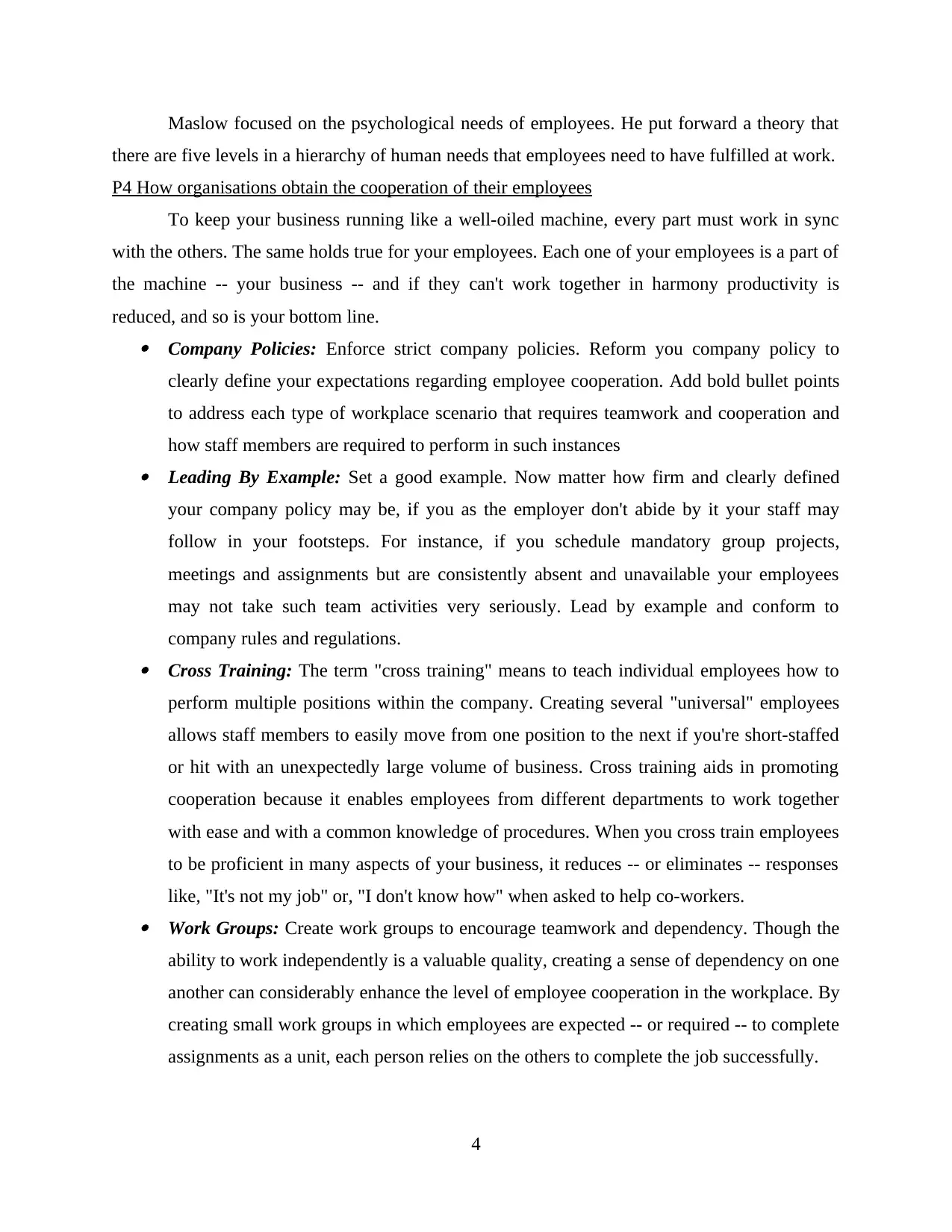
Maslow focused on the psychological needs of employees. He put forward a theory that
there are five levels in a hierarchy of human needs that employees need to have fulfilled at work.
P4 How organisations obtain the cooperation of their employees
To keep your business running like a well-oiled machine, every part must work in sync
with the others. The same holds true for your employees. Each one of your employees is a part of
the machine -- your business -- and if they can't work together in harmony productivity is
reduced, and so is your bottom line. Company Policies: Enforce strict company policies. Reform you company policy to
clearly define your expectations regarding employee cooperation. Add bold bullet points
to address each type of workplace scenario that requires teamwork and cooperation and
how staff members are required to perform in such instances Leading By Example: Set a good example. Now matter how firm and clearly defined
your company policy may be, if you as the employer don't abide by it your staff may
follow in your footsteps. For instance, if you schedule mandatory group projects,
meetings and assignments but are consistently absent and unavailable your employees
may not take such team activities very seriously. Lead by example and conform to
company rules and regulations. Cross Training: The term "cross training" means to teach individual employees how to
perform multiple positions within the company. Creating several "universal" employees
allows staff members to easily move from one position to the next if you're short-staffed
or hit with an unexpectedly large volume of business. Cross training aids in promoting
cooperation because it enables employees from different departments to work together
with ease and with a common knowledge of procedures. When you cross train employees
to be proficient in many aspects of your business, it reduces -- or eliminates -- responses
like, "It's not my job" or, "I don't know how" when asked to help co-workers. Work Groups: Create work groups to encourage teamwork and dependency. Though the
ability to work independently is a valuable quality, creating a sense of dependency on one
another can considerably enhance the level of employee cooperation in the workplace. By
creating small work groups in which employees are expected -- or required -- to complete
assignments as a unit, each person relies on the others to complete the job successfully.
4
there are five levels in a hierarchy of human needs that employees need to have fulfilled at work.
P4 How organisations obtain the cooperation of their employees
To keep your business running like a well-oiled machine, every part must work in sync
with the others. The same holds true for your employees. Each one of your employees is a part of
the machine -- your business -- and if they can't work together in harmony productivity is
reduced, and so is your bottom line. Company Policies: Enforce strict company policies. Reform you company policy to
clearly define your expectations regarding employee cooperation. Add bold bullet points
to address each type of workplace scenario that requires teamwork and cooperation and
how staff members are required to perform in such instances Leading By Example: Set a good example. Now matter how firm and clearly defined
your company policy may be, if you as the employer don't abide by it your staff may
follow in your footsteps. For instance, if you schedule mandatory group projects,
meetings and assignments but are consistently absent and unavailable your employees
may not take such team activities very seriously. Lead by example and conform to
company rules and regulations. Cross Training: The term "cross training" means to teach individual employees how to
perform multiple positions within the company. Creating several "universal" employees
allows staff members to easily move from one position to the next if you're short-staffed
or hit with an unexpectedly large volume of business. Cross training aids in promoting
cooperation because it enables employees from different departments to work together
with ease and with a common knowledge of procedures. When you cross train employees
to be proficient in many aspects of your business, it reduces -- or eliminates -- responses
like, "It's not my job" or, "I don't know how" when asked to help co-workers. Work Groups: Create work groups to encourage teamwork and dependency. Though the
ability to work independently is a valuable quality, creating a sense of dependency on one
another can considerably enhance the level of employee cooperation in the workplace. By
creating small work groups in which employees are expected -- or required -- to complete
assignments as a unit, each person relies on the others to complete the job successfully.
4
Paraphrase This Document
Need a fresh take? Get an instant paraphrase of this document with our AI Paraphraser
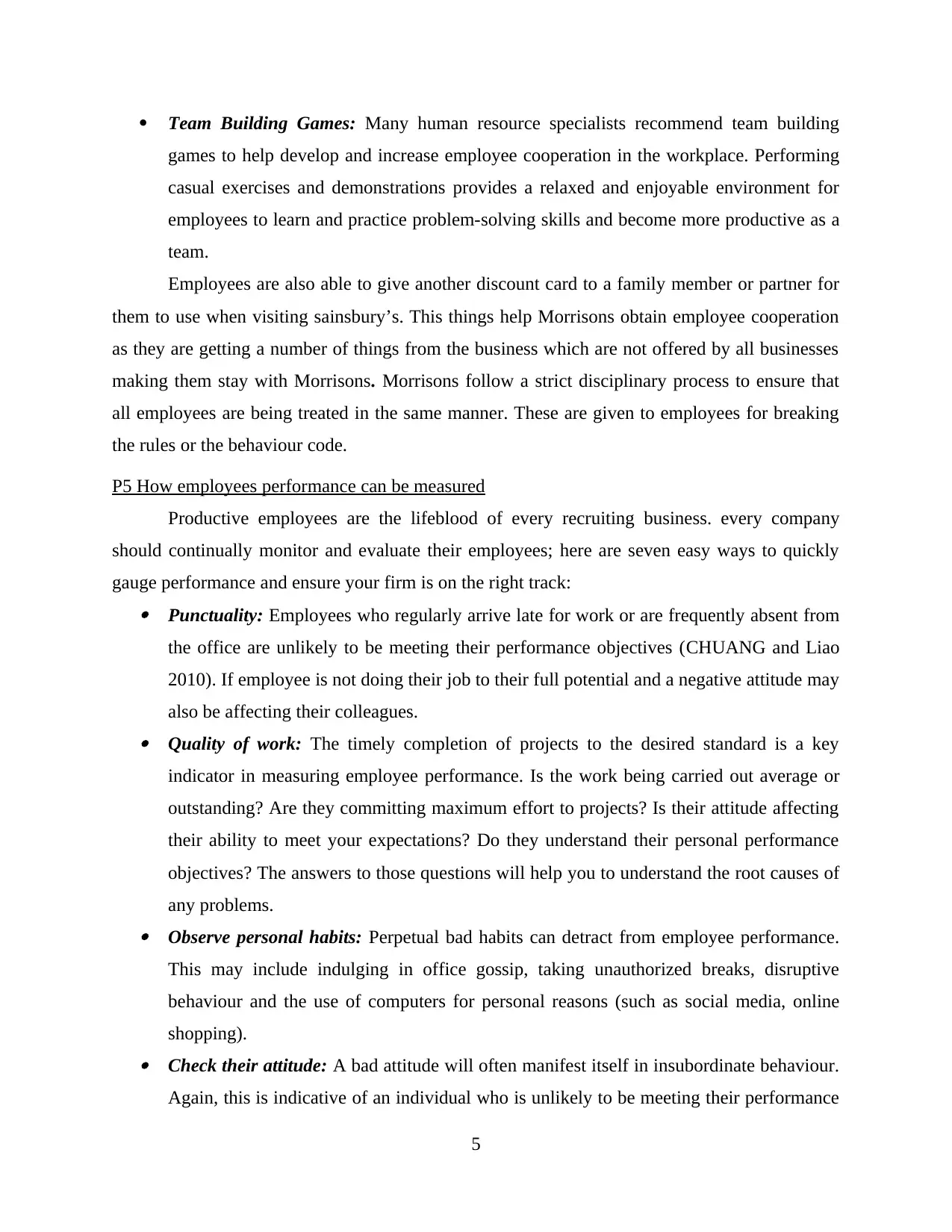
Team Building Games: Many human resource specialists recommend team building
games to help develop and increase employee cooperation in the workplace. Performing
casual exercises and demonstrations provides a relaxed and enjoyable environment for
employees to learn and practice problem-solving skills and become more productive as a
team.
Employees are also able to give another discount card to a family member or partner for
them to use when visiting sainsbury’s. This things help Morrisons obtain employee cooperation
as they are getting a number of things from the business which are not offered by all businesses
making them stay with Morrisons. Morrisons follow a strict disciplinary process to ensure that
all employees are being treated in the same manner. These are given to employees for breaking
the rules or the behaviour code.
P5 How employees performance can be measured
Productive employees are the lifeblood of every recruiting business. every company
should continually monitor and evaluate their employees; here are seven easy ways to quickly
gauge performance and ensure your firm is on the right track: Punctuality: Employees who regularly arrive late for work or are frequently absent from
the office are unlikely to be meeting their performance objectives (CHUANG and Liao
2010). If employee is not doing their job to their full potential and a negative attitude may
also be affecting their colleagues. Quality of work: The timely completion of projects to the desired standard is a key
indicator in measuring employee performance. Is the work being carried out average or
outstanding? Are they committing maximum effort to projects? Is their attitude affecting
their ability to meet your expectations? Do they understand their personal performance
objectives? The answers to those questions will help you to understand the root causes of
any problems. Observe personal habits: Perpetual bad habits can detract from employee performance.
This may include indulging in office gossip, taking unauthorized breaks, disruptive
behaviour and the use of computers for personal reasons (such as social media, online
shopping). Check their attitude: A bad attitude will often manifest itself in insubordinate behaviour.
Again, this is indicative of an individual who is unlikely to be meeting their performance
5
games to help develop and increase employee cooperation in the workplace. Performing
casual exercises and demonstrations provides a relaxed and enjoyable environment for
employees to learn and practice problem-solving skills and become more productive as a
team.
Employees are also able to give another discount card to a family member or partner for
them to use when visiting sainsbury’s. This things help Morrisons obtain employee cooperation
as they are getting a number of things from the business which are not offered by all businesses
making them stay with Morrisons. Morrisons follow a strict disciplinary process to ensure that
all employees are being treated in the same manner. These are given to employees for breaking
the rules or the behaviour code.
P5 How employees performance can be measured
Productive employees are the lifeblood of every recruiting business. every company
should continually monitor and evaluate their employees; here are seven easy ways to quickly
gauge performance and ensure your firm is on the right track: Punctuality: Employees who regularly arrive late for work or are frequently absent from
the office are unlikely to be meeting their performance objectives (CHUANG and Liao
2010). If employee is not doing their job to their full potential and a negative attitude may
also be affecting their colleagues. Quality of work: The timely completion of projects to the desired standard is a key
indicator in measuring employee performance. Is the work being carried out average or
outstanding? Are they committing maximum effort to projects? Is their attitude affecting
their ability to meet your expectations? Do they understand their personal performance
objectives? The answers to those questions will help you to understand the root causes of
any problems. Observe personal habits: Perpetual bad habits can detract from employee performance.
This may include indulging in office gossip, taking unauthorized breaks, disruptive
behaviour and the use of computers for personal reasons (such as social media, online
shopping). Check their attitude: A bad attitude will often manifest itself in insubordinate behaviour.
Again, this is indicative of an individual who is unlikely to be meeting their performance
5
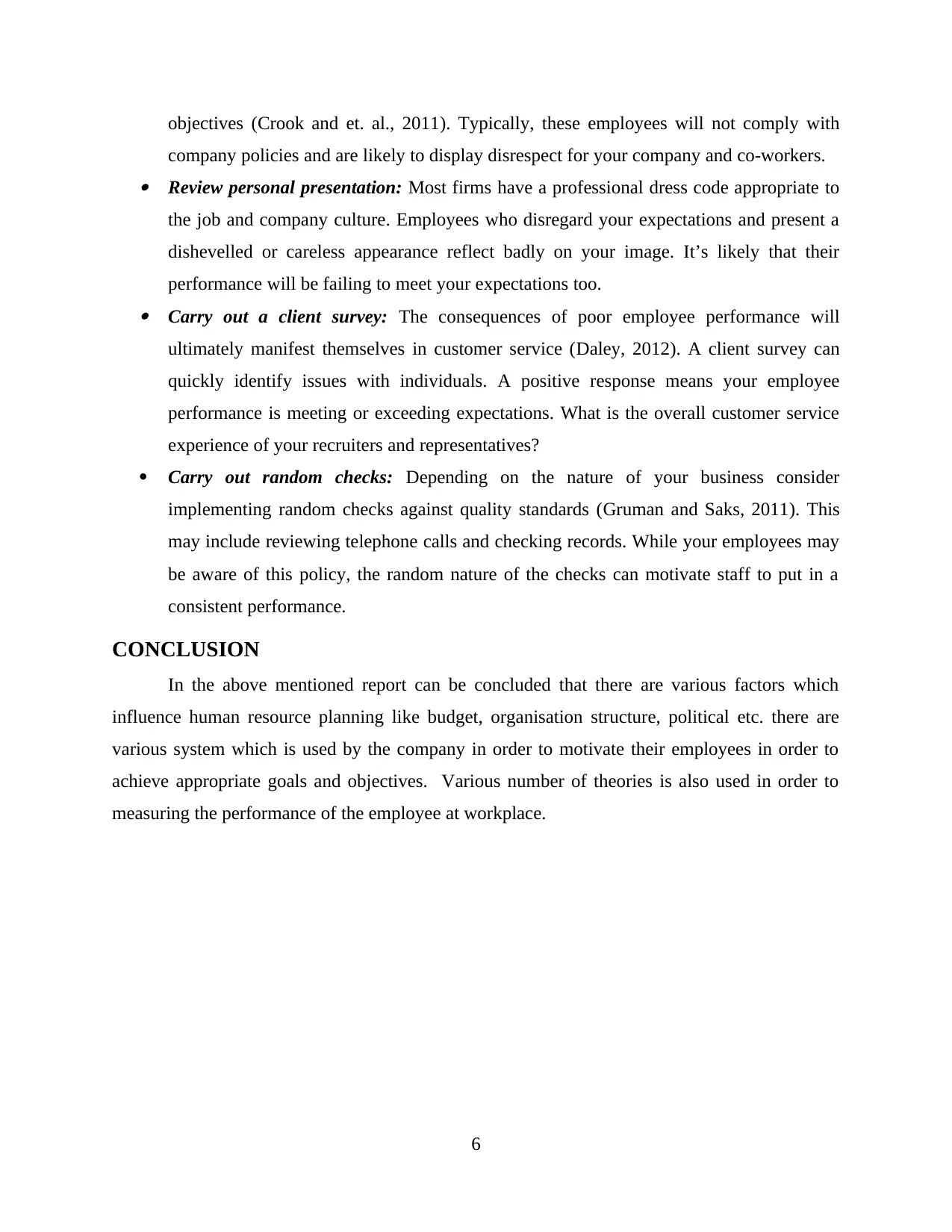
objectives (Crook and et. al., 2011). Typically, these employees will not comply with
company policies and are likely to display disrespect for your company and co-workers. Review personal presentation: Most firms have a professional dress code appropriate to
the job and company culture. Employees who disregard your expectations and present a
dishevelled or careless appearance reflect badly on your image. It’s likely that their
performance will be failing to meet your expectations too. Carry out a client survey: The consequences of poor employee performance will
ultimately manifest themselves in customer service (Daley, 2012). A client survey can
quickly identify issues with individuals. A positive response means your employee
performance is meeting or exceeding expectations. What is the overall customer service
experience of your recruiters and representatives?
Carry out random checks: Depending on the nature of your business consider
implementing random checks against quality standards (Gruman and Saks, 2011). This
may include reviewing telephone calls and checking records. While your employees may
be aware of this policy, the random nature of the checks can motivate staff to put in a
consistent performance.
CONCLUSION
In the above mentioned report can be concluded that there are various factors which
influence human resource planning like budget, organisation structure, political etc. there are
various system which is used by the company in order to motivate their employees in order to
achieve appropriate goals and objectives. Various number of theories is also used in order to
measuring the performance of the employee at workplace.
6
company policies and are likely to display disrespect for your company and co-workers. Review personal presentation: Most firms have a professional dress code appropriate to
the job and company culture. Employees who disregard your expectations and present a
dishevelled or careless appearance reflect badly on your image. It’s likely that their
performance will be failing to meet your expectations too. Carry out a client survey: The consequences of poor employee performance will
ultimately manifest themselves in customer service (Daley, 2012). A client survey can
quickly identify issues with individuals. A positive response means your employee
performance is meeting or exceeding expectations. What is the overall customer service
experience of your recruiters and representatives?
Carry out random checks: Depending on the nature of your business consider
implementing random checks against quality standards (Gruman and Saks, 2011). This
may include reviewing telephone calls and checking records. While your employees may
be aware of this policy, the random nature of the checks can motivate staff to put in a
consistent performance.
CONCLUSION
In the above mentioned report can be concluded that there are various factors which
influence human resource planning like budget, organisation structure, political etc. there are
various system which is used by the company in order to motivate their employees in order to
achieve appropriate goals and objectives. Various number of theories is also used in order to
measuring the performance of the employee at workplace.
6
⊘ This is a preview!⊘
Do you want full access?
Subscribe today to unlock all pages.

Trusted by 1+ million students worldwide
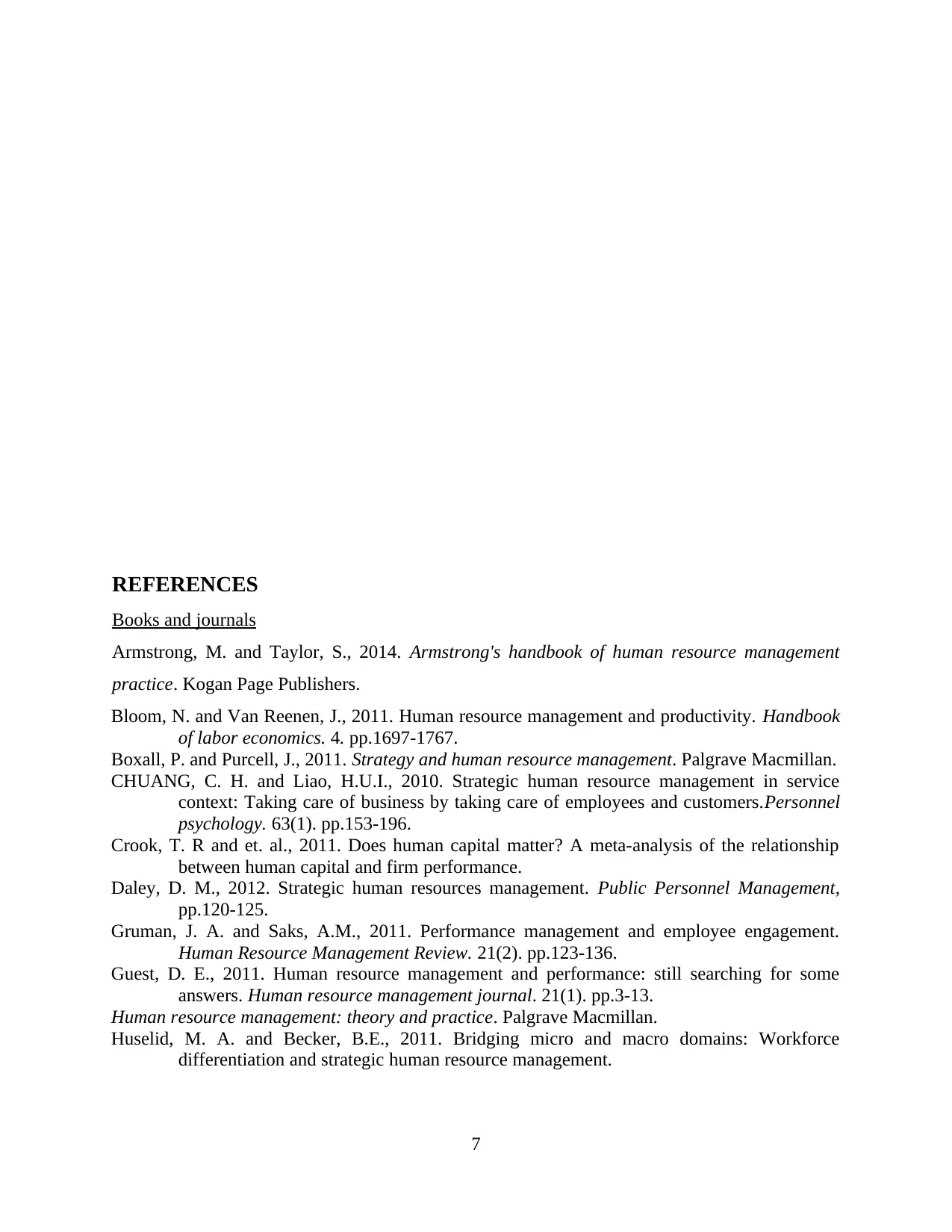
REFERENCES
Books and journals
Armstrong, M. and Taylor, S., 2014. Armstrong's handbook of human resource management
practice. Kogan Page Publishers.
Bloom, N. and Van Reenen, J., 2011. Human resource management and productivity. Handbook
of labor economics. 4. pp.1697-1767.
Boxall, P. and Purcell, J., 2011. Strategy and human resource management. Palgrave Macmillan.
CHUANG, C. H. and Liao, H.U.I., 2010. Strategic human resource management in service
context: Taking care of business by taking care of employees and customers.Personnel
psychology. 63(1). pp.153-196.
Crook, T. R and et. al., 2011. Does human capital matter? A meta-analysis of the relationship
between human capital and firm performance.
Daley, D. M., 2012. Strategic human resources management. Public Personnel Management,
pp.120-125.
Gruman, J. A. and Saks, A.M., 2011. Performance management and employee engagement.
Human Resource Management Review. 21(2). pp.123-136.
Guest, D. E., 2011. Human resource management and performance: still searching for some
answers. Human resource management journal. 21(1). pp.3-13.
Human resource management: theory and practice. Palgrave Macmillan.
Huselid, M. A. and Becker, B.E., 2011. Bridging micro and macro domains: Workforce
differentiation and strategic human resource management.
7
Books and journals
Armstrong, M. and Taylor, S., 2014. Armstrong's handbook of human resource management
practice. Kogan Page Publishers.
Bloom, N. and Van Reenen, J., 2011. Human resource management and productivity. Handbook
of labor economics. 4. pp.1697-1767.
Boxall, P. and Purcell, J., 2011. Strategy and human resource management. Palgrave Macmillan.
CHUANG, C. H. and Liao, H.U.I., 2010. Strategic human resource management in service
context: Taking care of business by taking care of employees and customers.Personnel
psychology. 63(1). pp.153-196.
Crook, T. R and et. al., 2011. Does human capital matter? A meta-analysis of the relationship
between human capital and firm performance.
Daley, D. M., 2012. Strategic human resources management. Public Personnel Management,
pp.120-125.
Gruman, J. A. and Saks, A.M., 2011. Performance management and employee engagement.
Human Resource Management Review. 21(2). pp.123-136.
Guest, D. E., 2011. Human resource management and performance: still searching for some
answers. Human resource management journal. 21(1). pp.3-13.
Human resource management: theory and practice. Palgrave Macmillan.
Huselid, M. A. and Becker, B.E., 2011. Bridging micro and macro domains: Workforce
differentiation and strategic human resource management.
7
Paraphrase This Document
Need a fresh take? Get an instant paraphrase of this document with our AI Paraphraser
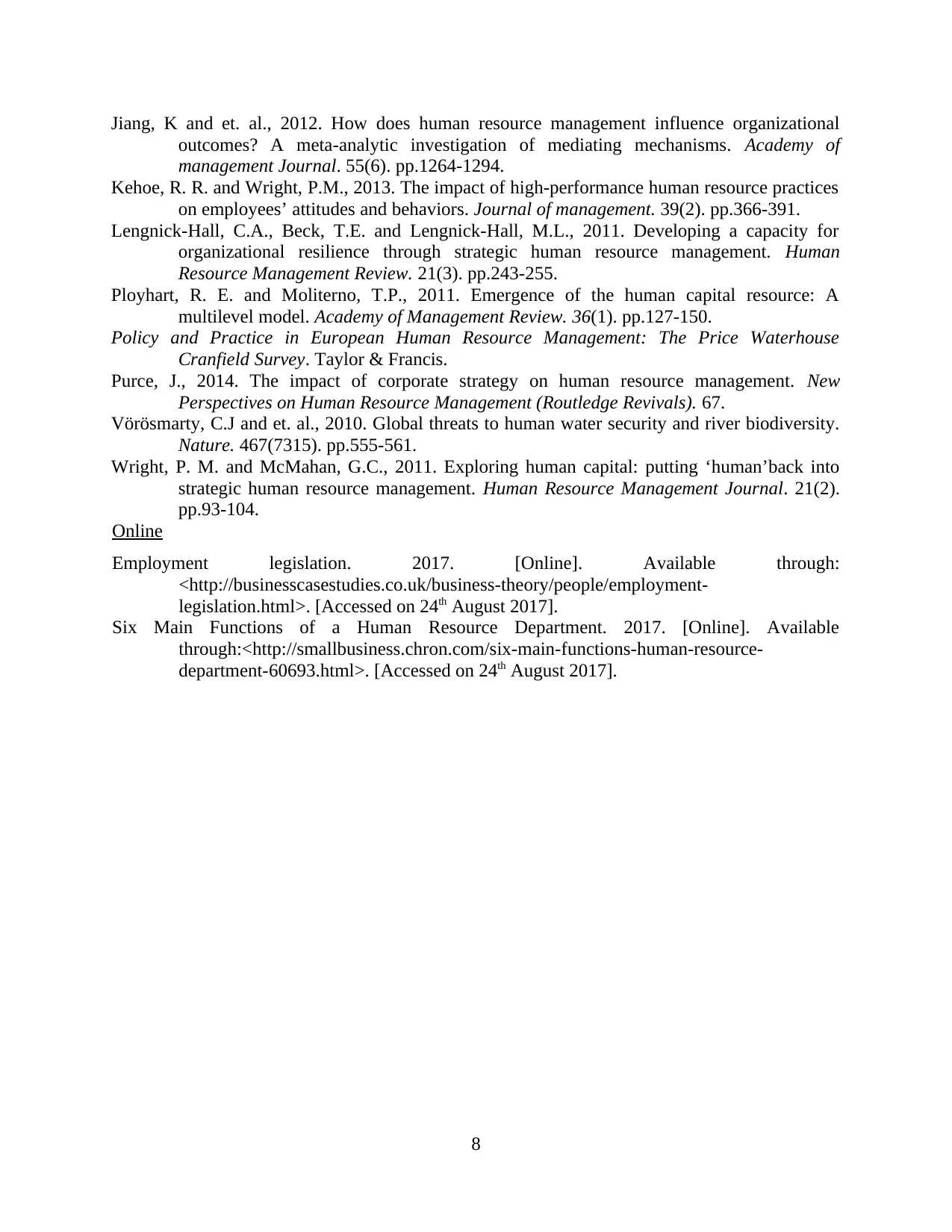
Jiang, K and et. al., 2012. How does human resource management influence organizational
outcomes? A meta-analytic investigation of mediating mechanisms. Academy of
management Journal. 55(6). pp.1264-1294.
Kehoe, R. R. and Wright, P.M., 2013. The impact of high-performance human resource practices
on employees’ attitudes and behaviors. Journal of management. 39(2). pp.366-391.
Lengnick-Hall, C.A., Beck, T.E. and Lengnick-Hall, M.L., 2011. Developing a capacity for
organizational resilience through strategic human resource management. Human
Resource Management Review. 21(3). pp.243-255.
Ployhart, R. E. and Moliterno, T.P., 2011. Emergence of the human capital resource: A
multilevel model. Academy of Management Review. 36(1). pp.127-150.
Policy and Practice in European Human Resource Management: The Price Waterhouse
Cranfield Survey. Taylor & Francis.
Purce, J., 2014. The impact of corporate strategy on human resource management. New
Perspectives on Human Resource Management (Routledge Revivals). 67.
Vörösmarty, C.J and et. al., 2010. Global threats to human water security and river biodiversity.
Nature. 467(7315). pp.555-561.
Wright, P. M. and McMahan, G.C., 2011. Exploring human capital: putting ‘human’back into
strategic human resource management. Human Resource Management Journal. 21(2).
pp.93-104.
Online
Employment legislation. 2017. [Online]. Available through:
<http://businesscasestudies.co.uk/business-theory/people/employment-
legislation.html>. [Accessed on 24th August 2017].
Six Main Functions of a Human Resource Department. 2017. [Online]. Available
through:<http://smallbusiness.chron.com/six-main-functions-human-resource-
department-60693.html>. [Accessed on 24th August 2017].
8
outcomes? A meta-analytic investigation of mediating mechanisms. Academy of
management Journal. 55(6). pp.1264-1294.
Kehoe, R. R. and Wright, P.M., 2013. The impact of high-performance human resource practices
on employees’ attitudes and behaviors. Journal of management. 39(2). pp.366-391.
Lengnick-Hall, C.A., Beck, T.E. and Lengnick-Hall, M.L., 2011. Developing a capacity for
organizational resilience through strategic human resource management. Human
Resource Management Review. 21(3). pp.243-255.
Ployhart, R. E. and Moliterno, T.P., 2011. Emergence of the human capital resource: A
multilevel model. Academy of Management Review. 36(1). pp.127-150.
Policy and Practice in European Human Resource Management: The Price Waterhouse
Cranfield Survey. Taylor & Francis.
Purce, J., 2014. The impact of corporate strategy on human resource management. New
Perspectives on Human Resource Management (Routledge Revivals). 67.
Vörösmarty, C.J and et. al., 2010. Global threats to human water security and river biodiversity.
Nature. 467(7315). pp.555-561.
Wright, P. M. and McMahan, G.C., 2011. Exploring human capital: putting ‘human’back into
strategic human resource management. Human Resource Management Journal. 21(2).
pp.93-104.
Online
Employment legislation. 2017. [Online]. Available through:
<http://businesscasestudies.co.uk/business-theory/people/employment-
legislation.html>. [Accessed on 24th August 2017].
Six Main Functions of a Human Resource Department. 2017. [Online]. Available
through:<http://smallbusiness.chron.com/six-main-functions-human-resource-
department-60693.html>. [Accessed on 24th August 2017].
8
1 out of 11
Related Documents
Your All-in-One AI-Powered Toolkit for Academic Success.
+13062052269
info@desklib.com
Available 24*7 on WhatsApp / Email
![[object Object]](/_next/static/media/star-bottom.7253800d.svg)
Unlock your academic potential
Copyright © 2020–2025 A2Z Services. All Rights Reserved. Developed and managed by ZUCOL.





